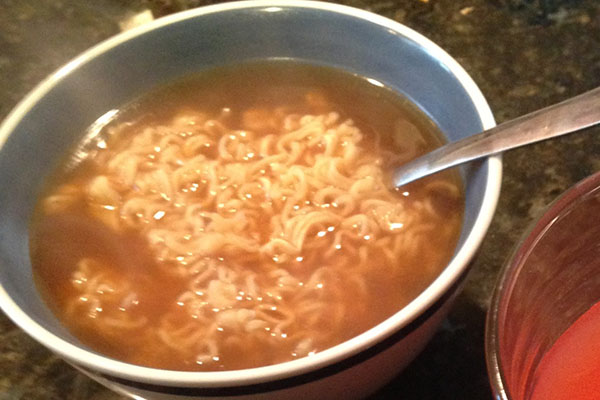I literally ate a bunch of ramen noodles to tell you what the best flavor is

Beef flavored ramen might be less traditional than chicken, but boasts a thicker broth.
January 20, 2015
Like Austin Powers, I like to live dangerously. So dangerously that every ramen noodle flavor ever produced has been wolfed down and digested by yours truly.
Ramen noodles have been one of the consistent staples of my diet in my 16 years of living. It never fails to make a quick, easy, and flat out delicious meal. What also makes ramen noodles astounding are the fact that you can tweak them to your bidding. You can easily add eggs and have yourself egg drop ramen soup, for which I would advise scrambling the eggs in a little cup and pouring it in at the last minute, allowing the scrambled eggs to cook with the noodles for the last minute or two.
This leads to the golden question. The question that the Gods in heaven reflect on, what the serene monks in China dwell on during meditation.
What is flavor of ramen is the best flavor?
Of course there will be flavors left out due to being so rare that they have almost an underground status among ramen connoisseurs such as myself. So we’ll look at the most available flavors of ramen noodles, and eventually come to the conclusion of which is the best flavor ramen has to offer.
Chicken: Chicken flavored ramen has remained a staple in many of the ramen diets of college students, and even normal middle class folk alike. It is almost known as the poster boy of ramen noodles. Every person, young and old, has set their sweet innocent eyes on the infamous orange packaging at least once in their lifetime. What makes this flavor of ramen noodles great is that it’s the original. It’s the architect of the flavors, and usually this is the flavor the average Joe associates ramen noodles with. Adding to the list of why chicken flavored ramen is a great flavor is that it’s the most easily hacked flavor. You can basically throw in any foreign spices and watch as your chicken flavored ramen turns into super duper ramen.
Beef: Beef has been the second choice for most ramen fans, due to it’s red packaging usually lingering next to the well established chicken flavored ramen. Beef is a more macho flavor in my opinion, as it turns weaklings into beefcakes, and the seasoning tends to make more thicker broth with the noodles. Do I have scientific evidence of this? Nope, just my word, so put your trust into me. Also, if you pull that old trick where you drain the noodles and then add the seasoning to the drained noodles, it tends to give off a really overwhelming flavor. That really is the only beef I have with this flavor. Otherwise, it’s a great flavor and really does live up to it’s reputation as the muscle of the ramen flavor family.
Oriental: Despite it’s name suggesting it has an eastern flavor, it does not. Oriental ramen lives a life of deceit. If you are able to get past the blatant lie that clouds over it’s blue packaging, you will find yourself enjoying an otherwise great flavor of ramen noodle. The smell can be overbearing when you first add the seasoning to the noodles. That smell however, is part of it’s charm. It’s almost as if the smell massages your senses, preparing you for the flavor that is going to just rock your world, akin to the concert scene from the Lost Boys with the really buff guy rocking out on a saxaphone. The flavor of the oriental ramen can be described as a mix of the pork flavored and beef flavored ramen. It proves to be enjoyable, and I can’t find any major faults that would result in my overall dissatisfaction of the product. Good job ramen guys, good job.
Shrimp: If you enjoy seafood, I would recommend this flavor fo’ sho. Don’t let the pink package fool you, because this flavor does pay great homage to the original seafood monarch that is Shrimp. When you take your first bite, you might get a hint of the oriental flavor. Trust me, that is normal. After that first second it hits your mouth, the oriental taste will cower in the corner, only to allow the shrimp flavor kick down the door to your taste buds. Being a shrimp fan in general, I find this flavor to be inventive and revolutionary in the ramen world. The flavor gives hope to a new breed of ramen noodle flavors, and potentially open new doors to ramen flavors all over the world.
Chili: It’s spicy.
Pork: Last but not least comes the myth, the legend, the Ghostface Killah of the ramen noodle family, pork flavored ramen. Everytime I try to spread the good word of this flavor, everyone has spew out the same phrase: “Pork ramen? Sounds groosss.” Yeah well guess what, you naysaying conformist vermin, you all are wrong and I am right, because pork flavored ramen is the knees of the bee. Though what sets pork apart from the beef and chicken flavors? What sets it apart from all other flavors is how rich the taste is. As soon as you start slurping up noodles, you can feel the sensation of a delight tingle from your feet up to your pectoral regions. It’s almost like the feeling you get when you meet a really cool girl and you start to get the hots for her. Except in this case, the hots are for ramen. Pork flavored ramen. The flavor is unique to itself, and doesn’t come off as a revamped version of beef or oriental. There are no drawbacks to this flavor, and I truly believe that this seasoning is a Unicorn’s dandruff.
I’ve written in great detail about each of these flavors, and I believe my decision remains very clear as to what is the greatest of all flavors. The Ghostface Killah of the ramen noodle family, Pork Ramen. Nothing can beat the originality in the flavor, nor the fact that it is euphoric in it’s own weird food way. The last words I can leave you Clarion readers with is that life is too short to judge any book by it’s cover. You really have to keep an open mind when it comes to the flavors of any factory manufactured noodles compressed into a single plastic package bearing the name of a classic Japanese dish.


oliver • Apr 11, 2022 at 8:29 pm
Ms. Mortensen has a point but honestly yolo bro, if you want to eat ramen, all the power to ya, i mean i’m eating a bowl of death squiggles and enjoying every poisonous noodle, but this is the greatest article ever and i’m glad i read it
cadence • Mar 30, 2021 at 2:43 pm
this is easily best article i’ve ever found by accident.
Ms. Mortensen • Jan 29, 2015 at 10:48 am
Dear Zach, while I admire your superior investigative skills and hilarious sense of humor, I’m more concerned for your health. Those ramen noodles are potential killers, packed in Styrofoam as in full of bisphenol. And those things called noodles are full of MSG and that nasty chemical tertiary-butylhydroquinone (TBHQ). I hope everyone realizes and appreciates you risking so much for all of us at RBHS!!
Check this out….
http://www.washingtonpost.com/national/health-science/all-those-instant-noodles-you-eat-may-put-you-at-risk-for-heart-problems/2014/08/29/e1181a32-2a36-11e4-958c-268a320a60ce_story.html
Ms. Mortensen